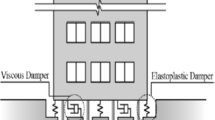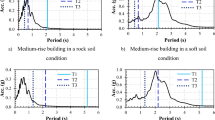Abstract
Evaluating inelastic displacement demand of structures exposed to seismic hazard is required for the design of new buildings as well as for seismic risk assessment of existing structures. Most of the buildings are designed to withstand strong earthquakes by responding in the nonlinear range. Having special parts of the structure designed to develop a stable hysteretic behaviour allows the structure to deform in order to accommodate the displacement demand imposed by strong ground motions. This paper is centred on finding a correspondence between the maximum elastic and inelastic displacement responses of the single degree of freedom (SDOF) systems subjected to earthquakes generated by Vrancea seismic source. Vrancea intermediate-depth earthquakes are responsible for the seismic hazard throughout Romanian territory. They have distinctive features, such as large displacement demand and large predominant periods, which makes Romania a special seismic environment. Using a database of Romanian and Japanese strong ground motions generated by intermediate-depth earthquakes and performing nonlinear dynamic analysis on the SDOF oscillators following the Takeda model, this study estimates the inelastic to elastic displacement ratio of reinforced concrete systems. Soil conditions, epicentral distance and magnitude influence on inelastic response is analysed using constant ductility response spectra. The main findings of the study are: the local increase of the inelastic to elastic displacement ratio for type C soil (Eurocode 8 classification) for large magnitude earthquakes and the significant effect of soil conditions on the inelastic response of the SDOF systems. The inelastic amplification was evaluated using a functional form depending on system ductility, soil conditions and earthquake magnitude.





















Similar content being viewed by others
Data availability
The data presented in this study are available on request from the corresponding author.
Code availability
Not applicable.
References
Akkar S (2016) Utility software for data processing. Retrieved from USDP: Accesed on 28 November 2016 http://web.boun.edu.tr/sinan.akkar/usdp1.html
ASCE (2017) Minimum design loads and associated criteria for buildings and other structures. American Society of Civil Engineers, Reston
ATC-40 (1996) Seismic evaluation and retrofit of concrete buildings. Applied Technology Council, Redwood City, California
Bazzurro P, Cornell A (1999) Disaggregation of seismic hazard. Bull Seismol Soc Am 89(2):501–520
CEN (2004) European Standard EN 1998–1:2004 Eurocode 8: design of structures for earthquake resistance, Part 1: general rules, seismic actions and rules for buildings. Comite Europeen de Normalisation, Brussels
Chopra A (2012) Dynamics of structures. Theory and applications to earthquake engineering, 4th edn. Prentice Hall, Upper Saddle River
Chopra A, Chintanapakdee C (2004) Inelastic deformation ratios for design and evaluation of structures: single-degree-of-freedom bilinear systems. J Struct Eng 130(9):1309–1319
Chopra A, Goel R (2001) Direct displacement-based design: use of inelastic vs. elastic design spectra. Earthq Spectra 17(1):47–64. https://doi.org/10.1193/1.1586166
Clough R, Penzien J (2003) Dynamics of structures, 3rd Edition. Computers & Structures, Inc
Crăciun I, Văcăreanu R, Pavel F (2016) Spectral displacement demands for strong ground motions recorded during Vrancea intermediate-depth earthquakes. In: Văcăreanu R, Ionescu C (eds) The 1940 Vrancea earthquake. Issues, insights and lessons learnt. Springer, Bucureşti, pp 169–188
Craifăleanu I (2005) Modele neliniare cu un grad de libertate în inginereia seismică. Bucharest, MatrixRom
CUREe (1992) Design guidelines for ductility and drift limits. Report CK92–03A. California Universities for Research in Earthquake Engineering ( CUREe), Kajima Corporation Research Project
FEMA273 (1997) NEHRP Guidelines for the seismic rehabilitation of buildings. Applied Technology Council, Redwood City, California
FEMA356 (2000) Prestandard and commentary for the seismic rehabilitation of buildings. American Society of Civil Engineers, Reston
FEMA440 (2005) Improvement of nonlinear static seismic analysis procedures. Applied Technology Council, Redwood City, California
Frohlich C (2006) Deep earthquakes. Cambridge University Press, Cambridge, pp 535–541
Goda K, Atkinson G (2009) Seismic demand estimation of inelastic SDOF systems for earthquakes in Japan. Bull Seismol Soc Am 99(6):3284–3299. https://doi.org/10.1785/0120090107
Gulkan P, Sozen M (1974) Inelastic responses of reinforced concrete structures to earthquake motions. J Am Concr Inst Proc 71(12):604–610
Gutunoi A, Zamfirescu D (2013) Study on relation between inelastic and elastic displacement for Vrancea earthquakes. Math Model Civ Eng. https://doi.org/10.2478/mmce-2013-0016
Hassani N, Amiri G, Bararnia M, Sinaeian F (2017) Ground motion prediction equation for inelastic spectral displacement in Iran. Sci Iran B 2017(24):164–182
Lungu D, Ghiocel D (1982) Metode probabilistice în calculul construcțiilor. Editura Tehnică, Bucureşti
Lungu D, Aldea A, Arion C, Văcăreanu R (2003) Hazard, vulnerabilitate şi risc seismic. In: Dubină D, Lungu D (eds) Construcţii amplasate în zone cu mişcări seismice puternice. Editura Orizonturi Universitare, Timişoara, pp 21–157
MDRAP (2013) P100-1/2013 code for seismic design—Part I—Design prescriptions for buildings. Ministry of Regional Development and Public Administration, Bucharest, Romania
Michel C, Lestuzzi P, Lacave C (2014) Simplified non-linear seismic displacement demand prediction for low period structures. Bull Earthq Eng 12:1563–1581. https://doi.org/10.1007/s10518-014-9585-1
Miranda E (2000) Inelastic displacement ratios for structures on firm sites. J Struct Eng 126(10):1150–1159
Miranda E (2001) Estimation of inelastic deformation demands of SDOF systems. J Struct Eng 127(9):1005–1012
Miranda E, Bertero V (1994) Evaluation of strength reduction factors for earthquake-resistant design. Earthq Spectra 10(2):357–379
Miranda E, Ruiz Garcia J (2003) Inelastic displacement ratios for evaluation of existing structures. Earthq Eng Struct Dyn 32:1237–1258. https://doi.org/10.1002/eqe.271
Miranda E, Ruiz-Garcia J (2007) Probabilistic estimation of maximum inelastic displacement demands for performance-based design. Earthq Eng Struct Dyn 36:1235–1254. https://doi.org/10.1002/eqe.680
Nassar A, Krawinkler H (1991) Seismic demands for SDOF and MDOF systems. Rep. No. 95, John A. Blume Earthquake Engineering Center, Stanford Univ., Stanford, California
Olteanu P, Vacareanu R (2020) Ground motion model for spectral displacement of intermediate-depth earthquakes generated by Vrancea seismic source. Geosciences 10(8):282. https://doi.org/10.3390/geosciences10080282
Pavel F, Vacareanu R, Aldea A, Arion C (2013) Source effects on the spectral characteristics of strong ground motions recorded in Bucharest area during Vrancea earthquakes of 1986 and 1990. J Earthq Eng 17(8):1192–1211. https://doi.org/10.1080/13632469.2013.830997
Pavel F, Vacareanu R, Calotescu I, Coliba V (2017) Design displacement response for southern and eastern Romania. In: Proceedings of 16th World Conference on Earthquake Engineering, 16WCEE 2017. Santiago Chile, Chile, January 9th–13th 2017 Paper No 1926
Priestley M, Calvi G, Kowalsky M (2007) Displacement-based seismic design of structures. IUSS Press, Pavia
Rathje E, Abrahamson N, Bray J (1998) Simplified frequency content estimates of earthquake ground motions. J Geotech Geoenviron Eng 124(2):150–159
Ruiz-García J, Miranda E (2006) Inelastic displacement ratios for evaluation of structures built on soft soil sites. Earthq Eng Struct Dyn 35(6):679–694. https://doi.org/10.1002/eqe.552
Shibata A, Sozen M (1974) The substitute structure method for earthquake-resistant design of reinforced concrete frames. Report UILU-ENG. 74–2027, University Of Illinois Urbana-Champaign Urbana, Illinois, October 1974
Takeda T, Sozen M, Nielsen N (1970) Reinforced concrete response to simulated earthquakes. J Struct Div 96(12):2257–2273
Tothong P, Cornell A (2006) An empirical ground-motion attenuation relation for inelastic spectral displacement. Bull Seismol Soc Am 96(6):2146–2164. https://doi.org/10.1785/0120060018
Vacareanu R, Radulian M, Iancovici M, Pavel F, Neagu C (2015) Fore-arc and back-arc ground motion prediction model for Vrancea intermediate depth seismic source. J Earthq Eng 19:535–562. https://doi.org/10.1080/13632469.2014.990653
Veletsos A, Newmark N (1960) Effect of inelastic behavior on the response of simple systems to earthquake motions. In: Proceedings of the 2nd World Conference on Earthquake Engineering, Japan, 11–18 July 1960, pp 895–912
Veletsos A, Neewmark N, Chelapati C (1965) Deformation spectra for elastic and elastoplastic systems subjected to ground shock and earthquake motions. In: Proceedings of the 3rd World Conference on Earthquake Engineering Vol 2, 3WCEE 1965, Wellington, New Zealand, 22 January–1 February 1965
Acknowledgements
The authors would like to thank National Research Institute for Earth Science and Disaster Resilience (NIED, http://www.kyoshin.bosai.go.jp/) for providing access to K-NET and Kik-net ground motion record databases. The support of Mr. Florin Pavel throughout the development of this study is greatly acknowledged. The authors would like to express their gratitude for the constructive comments received from two anonymous reviewers who helped to improve considerably the quality of this article.
Funding
This research received no external funding.
Author information
Authors and Affiliations
Corresponding author
Ethics declarations
Conflicts of interest
The authors declare that they have no conflict of interest.
Additional information
Publisher's Note
Springer Nature remains neutral with regard to jurisdictional claims in published maps and institutional affiliations.
Rights and permissions
About this article
Cite this article
Olteanu, P., Vacareanu, R. Inelastic displacement demand of RC buildings subjected to earthquakes generated by intermediate-depth Vrancea seismic source. Nat Hazards 109, 2509–2534 (2021). https://doi.org/10.1007/s11069-021-04930-3
Received:
Accepted:
Published:
Issue Date:
DOI: https://doi.org/10.1007/s11069-021-04930-3




